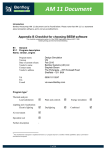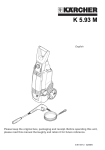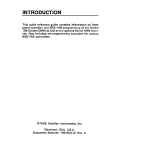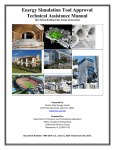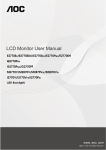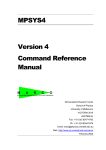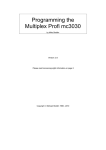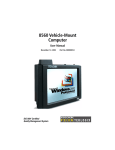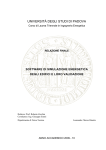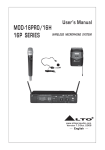Download AM 11 Document
Transcript
AM 11 Document Introduction Bentley Hevacomps AM 11 document can be found below. Please note that AM 11 is a statement about simulation software, and is not an accredited item. Appendix B Checklist for choosing BEEM software This checklist complements section 4 of the CIBSE Applications Manual AM11:1998 Building Energy and Environmental Modelling B1 General B1.1 Program description Name, vendor, origins Program name Version Date of current release Vendor’s name Contact name Vendor’s address Design Simulation V2 Feb 2008 Bentley Systems (UK) Ltd Stephen Brown Smithywood House, Smithywood Crescent Sheffield S8 0NU Tel Fax E-mail 0114 255 6680 0114 255 6638 [email protected] Program type1 Thermal analysis: Load calculation Plant and controls Energy simulation Lighting and visualisation: Electric lighting Daylighting Combined Air movement Specialist tool Further description - 1 The classification of programs is explained in Section 2. A program may have a number of listed capabilities. Space is provided to elucidate the description. 1 of 15 AM 11 Document Program history2 Description Design simulation was first produced in 2007 and incorporates Hevacomp CAD input. The simulation engine is EnergyPlus. 2 List previous names by which program known, significant advances in functionality and dates of these, changes of platform and changes of vendors. This information will help in the understanding of published literature, especially about validation studies. 2 of 15 AM 11 Document B1.2 Computer specification Platform and operating system PC Unix® Apple Macintosh® Comments Yes MS-dos® Windows 95® ps2 Yes Yes No Windows 3.x® Windows nt® os2 No No Can be run from either the PC or the Server Machine with Control from a License Manager run from a server machine. Processor, storage and peripherals Processor speed 3 Minimum RAM 1 Minimum disk space 10 Other devices: Floppy disk Yes cd-rom drive Yes Printer Yes Plotter Yes Digitising table Yes Other GHz, recommended quad core GB, recommended 2 gig GB No No No No No Plotter is optional. A LAN connection is required. Other requirements3 Screen resolution > 800x600, Internet connection required for update patches, network connection required for license manager Suitable machines4 software. Most modern PCs will have no trouble running the 3 4 Consider screen size, video RAM, Internet connection, local area network connection, etc. List types of machine known to be suitable 3 of 15 AM 11 Document B1.3 Program code Type of code Compiled code only Source code available Extra £ for source code Programming language No No No C/C++ - Notes B1.4 Yes Yes Yes Fortran Modelling methods The Design Simulation program uses the EnergyPlus simulation engine B1.5 Input interface Type of interface GUI Other Menu-driven Command line Digital data file Program produces accessible and human readable digital data files? 5 Legibility of digital file Is entire problem definition contained?6 Are all simulation parameters included?‡7 Yes Good Yes Yes No Poor No No Data checking Does program check for consistency and plausibility of input? Yes No 5 Bad Interfaces may generate files (e.g. binary files) which cannot be read by people but only by the program interface. These are much less useful and old (binary) files may cease to be readable by new versions of the interface. 6 Check that all the data are included — e.g. geometry, construction and occupancy data — and that the weather file used is noted. 7 Check that all the simulation control information — such as time-step length, length of preconditioning and convergence criteria — is given. 4 of 15 AM 11 Document B1.6 Output interface Type of interface GUI Tabular Digital data Is digital output accessible? Yes Legibility of digital file Good Is all output contained? Yes Are algorithm level outputs accessible? No Poor No Yes B1.7 Linked modules CAD input Yes No 8 Vendor’s own interface Yes No Other cad system(s) (name) AutoCAD DXF files Comments 9 Bad No Yes Yes Yes Yes No No No No Yes Yes 7900 No No - Weather data Worldwide Number of sites 8 The software uses AutoCAD DXF files as a template for inputting data B1.8 Associated databases Thermophysical properties Basic material properties Properties of complete construction Transmission of windows Comment9 Digital Comment - Other databases - Check that the modules are available and working; consult vendors about likely future releases. Ask how many entries are in each database; ask to see some of their contents. 5 of 15 AM 11 Document B1.9 User support Manuals User manual Hard copy On-line Yes Yes Yes Date of the latest copy No No No February 2009 Does it include example problems with the expected answers? Do the problems exercise all program modules? Does it explain how to use every module? Comments10 - Yes No Yes No Yes No Yes Yes Yes Yes No No No No Case studies Vendor’s case study examples obtained? Case studies of others obtained? Yes Yes No No Hotline Hotline support Turn round Yes Instant Technical manual Hard copy On-line On-line help Comments 10 - No 1 day Ask to see the manual. Ensure that it contains all the useful features and that it is up to date. 6 of 15 >1 day AM 11 Document Software Updates provided Media for dissemination Training Courses provided Cost Length Frequency B1.10 User base Numbers Users in UK 10,500 Sites in UK 1,500 UK building services engineers UK architects UK builders UK others Is there a user club? Contacts Name Address Tel Fax E-mail No CD Yes No from £350 Details available Details available Yes Floppy disk Users worldwide Sites worldwide 10,500 Yes Support and Sales Bentley Systems (UK) Ltd Smithywood House Smithywood Crescent Sheffield S8 0NU 0114 255 6680 0114 255 6638 [email protected] 7 of 15 No Internet 11,800 1,630 AM 11 Document B1.11 Cost Software and associated databases Core program Name Name Name Databases Name Name First year user /licence fee £2000 first seat £1000 additional seats £ £ £ £ £ £ Total software and data £ Computer Name Annual recurring licence fee after first year of use Typical training course fees per year £ £ £ Modules B1.12 Accuracy Has the program been evaluated? Does the vendor exercise routine in-house quality testing? Yes No Yes No Complete the table below to document the validation history Date tested Aug 07 Nov 07 Nov 07 Nov 07 Nov 07 Independently (i) or by vendor (v) Type of test A, C, E (i) (i) (i) (i) (i) E A A A A Source of information CLG Part L ASHRAE ASHRAE ASHRAE 120 BESTest A Analytical verification, C Intermodel comparison, E Empirical validation 8 of 15 Comments on the results Accreditation test HVAC Tests Fabric tests AM 11 Document B2 Thermal simulation programs: theoretical basis B2.1 Conduction and thermal storage11 Solution method Explicit finite difference Respnse factor Other Time-step length User specified Implicit finite difference Weighting factors Calculated by program Three-dimensional User specified Multi-layer with nodes - Opaque surface: conduction model One-dimensional Opaque layers: node placement Fixed at (number) applicable Other - Glazing: conduction model Resistance or U-value Other Air gaps User specified resistance Other Initial node temperature User specified Notes Preconditioning time User specified Not - Program calculated resistance - Program calculated Program recommended - 11 Validation work indicates that conduction and thermal storage are well modelled in the programs studied. Alternative approaches generally have little impact on results and a small impact on program run times. The ability to conduct three-dimensional analyses is rarely needed. For modelling a large area of glass, especially heat-absorbing glass, windows are best modelled as multi-layer constructions. 9 of 15 AM 11 Document B2.2 Solar radiation External solar radiation12 Direct and diffuse combined Separate treatment of direct and diffuse Ground reflection of radiation13 Considered Not considered Diffuse radiation sky model14 Isotropic Notes - Anisotropic Window transmission — direct15 User specified Other/notes - Program calculated Window transmission — diffuse User specified Other/notes - Program calculated Calculated once by program Internal solar distribution16 User specified (fixed) to one or more surfaces Calculated at each time step Notes - 12 Solar radiation and its reflection are best calculated if the direct and diffuse radiation components are separated. Ground reflection must be calculated, especially for more highly glazed spaces (such as atria). 14 Anistropic diffuse solar radiation models are generally considered superior. 15 Window transmission may be calculated by the program, or the user may specify incidence angle dependent values. For direct solar radiation, incidence angle dependent transmission and reflection (or absorption) properties are necessary; a single value is often used for diffuse radiation. Correct specification for direct radiation is most important. Software is available to calculate incidence angle dependent values if programs require users to specify these and databases are inadequate. 16 The distribution of internal solar radiation is usually important only where glazed areas are large, surfaces have very different thermal mass or a number of surfaces are glazed. The retransmission through other glazed surfaces can be very important for modelling e.g. conservatories or atria— note the treatment of this effect. 13 10 of 15 AM 11 Document B2.3 Surface heat exchange Internal surfaces17 Combined convection and radiation coefficient Separate convection and radiation networks Internal combined coefficients18 Fixed user defined Program calculated once Calculated at each time-step Notes Not applicable Internal convection coefficients19 Fixed user defined Calculated at each time-step Notes Program calculated once Internal longwave exchange20 Star network Notes IntersuArface exchange Separate radiation and convection networks External surfaces21 Combined convection and radiation coefficient External combined coefficients 17 Some programs calculate heat exchange between surfaces and the enclosed air using a coefficient which describes both the convective and longwave effects. With such an approach the calculated space temperature is not a true air temperature; it is often termed the enclosure temperature. The true effects of highly asymmetric radiant environments (e.g. a radiant ceiling panel) are poorly predicted. The approach is, however, adequate for most spaces and where long-term (energy use) predictions are required. Note whether the approach used for glazing is the same as that used for opaque surfaces. 18 Ignore if separate convective and radiant exchange networks are employed. 19 Ignore if combined coefficients used. In reality coefficients vary depending on the surface-to-air temperature difference, surface length (or height), roughness etc. Note the algorithm used to describe these effects. 20 Ignore if combined coefficient used. A star network balances radiation exchange at a fictitious central node. Radiation actually occurs by intersurface exchange. A view factor calculation is needed to describe the intersurface visibility. Note whether exact or approximate view factors are used and whether the program calculates these. 21 The heat exchange at external surfaces may be calculated using a simple combined surface heat transfer coefficient or by separating out convection and radiation and modelling each of these in detail. Note whether the approach used for glazing is the same as that used for opaque surfaces. 11 of 15 AM 11 Document Fixed user defined Calculated at each time-step Program calculated once 12 of 15 AM 11 Document External convection coefficients22 Fixed user defined Calculated at each time-step Notes External longwave exchange23 User or program calculated coefficient Notes - Program calculated once Detailed algorithm B2.4 Heating, cooling and casual gains Heat input24 Combined radiant and convective Notes Cooling25 Sensible cooling only Notes Separate fixed radiant and convective components Sensible and latent cooling - - 22 If a separate treatment is adopted for external convection, note whether a fixed coefficient is used or a more detailed algorithm which may account for wind speed, direction and surface orientation is used. Although a rigorous approach is theoretically preferable, wind speeds and directions close to surfaces are difficult to calculate. 23 Longwave heat loss to surroundings has a significant impact on the temperature of external surfaces and, for glazed surfaces (and other poorly insulated areas), the temperature of the interior spaces. This has a significant impact on the comfort conditions, and perhaps the demands for heating, in highly glazed spaces such as atria. The exchange may be modelled by a single coefficient or a detailed algorithm may be adopted. The algorithm may calculate exchange to both the sky and surrounding surfaces (ground and buildings) or to ju st the sky. The method of calculating the sky temperature should be noted. 24 Heat input from plant and casual sources (people, lights and equipment) may have fixed radiant and convective components or the user may be able to specify these. The ability to specify will be important if, for example, a highly radiant source is used or if highly radiant sources are combined with convective sources. The ability to specify the latent proportion of casual heat gains may be similarly important, particularly regarding cooking equipment. Some programs use detailed models (e.g. which incorporate a time delay and an exponential temperature rise) so that heating plant can be more accurately modelled. This is less important for long-term (energy) calculations than for short term temperature predictions. 25 An ability to calculate the latent cooling load will be particularly important in humid environments. The ability to do this implies that the moisture content of the air is tracked by the program — few programs do this. 13 of 15 AM 11 Document Controlling plant26 Free-float Idealised control Ideal preheat/cool Fixed heat injection On/off thermostat Accelerator Proportional Proportional plus integral Proportional plus integral plus derivative Advanced (e.g. fuzzy logic, adaptive, selftuning, neural network) Other Yes Yes Yes Yes Yes Yes Yes Yes Yes No No No No No No No No No Yes No Schedules27 Repeated daily schedule Repeated hourly schedule Seasonal variations Flexible hourly schedule Notes Yes Yes Yes Yes No No No No Sensor types Sensing air temperature Mixed radiation and convection sensing Surface temperature sensing Intraconstruction sensing Notes Yes Yes Yes Yes No No No No 26 Most programs assume perfect control is possible, i.e. that a specified set point can be quickly achieved (provided plant capacities are sufficient); this is usually adequate for long-term energy calculations. In some programs the impact on temperature of alternative forms of control can be explored. 27 The ability to schedule heating and cooling plant and the occurrence of internal heat gains is important. Some programs are very flexible enabling minute-by-minute variations, others are less flexible. 14 of 15 AM 11 Document B2.5 Observations28 28 Record here any other general observations about the capabilities of the program which have not been covered elsewhere. For example, some programs impose geometric description limits on the maximum numbers of zones, surfaces per zone or windows per surface. 15 of 15
















